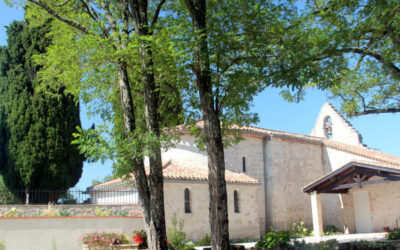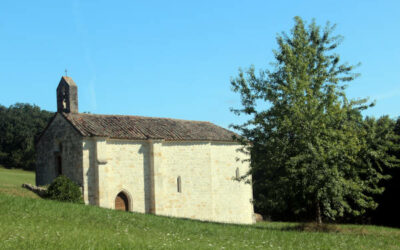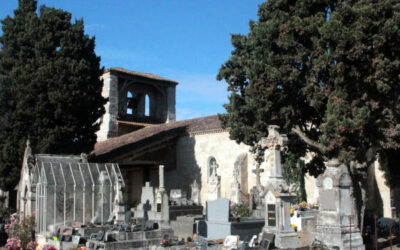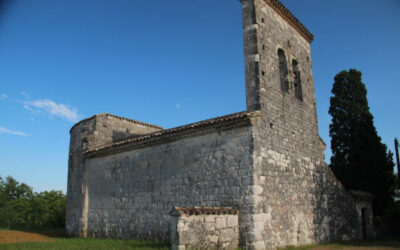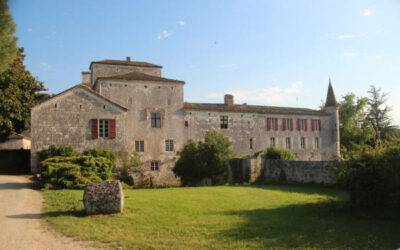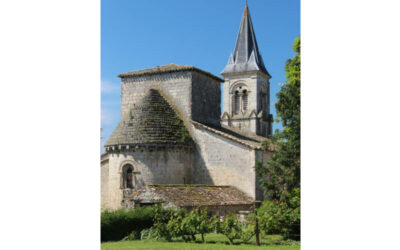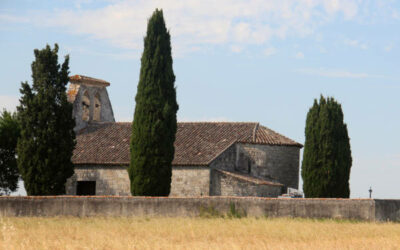This church is one of the oldest possessions of the Abbey of Saint-Maurin. Its attachment to the abbey was confirmed in 1281 under the abbatiate of Gausbert Girval by a deed signed with the bishop of Cahors.
Chapel of Notre Dame d’Aureillac
This chapel of the village of Saint-Urcisse stands at the crossing of two very busy roads, the Clermontoise, running from the Massif Central to the Garonne valley, and the Ténarèze, coming from the Pyrenees, a cattle road, or « draille ».
Church of Sainte Croix
The church of Sainte Croix de Punéjols is located in the village of Saint-Urcisse, not far from the chapel of Notre Dame d’Aureillac.
This chapel, dating from the 11th and 12th centuries, retains two Romanesque features: the north wall and the massive square tower that houses the bells.
Church of Saint Urcisse
This church gave its name to the village, which was originally called Saisimentum. It was not until later that the name “Saint Urcisse” was chosen.
Church of Saint Romain
Dedicated to Saint Roman, holy martyr persecuted and killed in Rome in 258, the usual name of this church is Saint Romain.
This church, imposing with its large wall belfry, dates from the beginning of the 16th century.
Church of Notre Dame de Cambot
The church of Notre Dame de Cambot, in the parish of Tayrac, once belonged to the abbey of Moissac. In 1236 the bishop of Agen gifted Cambot to the abbey of Saint-Maurin.
Church of Saint Sixte
The parish was a dependency of the Cauzac priory. In 1253 the rights of the Saint Maurin abbey over Saint Sixte and its annexe, Gandaille, were recognised by Guillaume, bishop of Agen.
Church of Saint Louis de Gandaille
This Romanesque church built of fine stones, laid in regular courses, has been recently restored. Only the nave is original.
In 1243 the abbot of Saint Maurin, Guillaume de Belpech, bought the tithe collection rights.
Mill and church ND de Ferrussac
The origins of the fortified mill of Ferrussac go back to the first centuries of our era. Indeed, the church located on the estate (Notre Dame de Ferrussac) most probably rests on the foundations of a Gallo-Roman villa, as attested by the ac ending of the name.
This fortified mill was bought by the abbot of Saint Maurin in 1424; Jean I de Boville usurped its rights and, after arbitration in 1452, kept the estate. It remained in the de Boville family and was offered in 1606 to Bertrand I d’Audevars.
Moirax
A village that has existed since antiquity according to some archaeological evidence, Moirax was a stopover for pilgrims on their way to Santiago de Compostela during the Middle Ages. In the 11th century, in 1049, one of the first Cluniac abbeys was founded here.
It became the Cluniac priory of Sainte-Marie and its church is now dedicated to Notre-Dame de Moirax.
Church of Saint Pierre es liens of Engayrac
The primitive construction seems to date back to the eleventh century. There remains from this period the choir covered with a dome on pendants and the apse in the bottom of the oven.
This parish church of Saint-Pierre es Liens d’Engayrac has the particularity of having a sanctuary that is narrower than the nave, consisting of an apse and a bay surmounted by a square tower (former bell tower).
Church of Saint Julien de la Serre
This charming chapel was founded by Hunaud de Gavarret, the second Cluniac abbot of Moissac. It was subsequently given to the Saint-Maurin abbey. The illustrious patronage of Moissac could explain the decoration in this otherwise modest chapel, above all its sculpted capitals.
It is one of St Maurin abbey’s oldest possessions.


